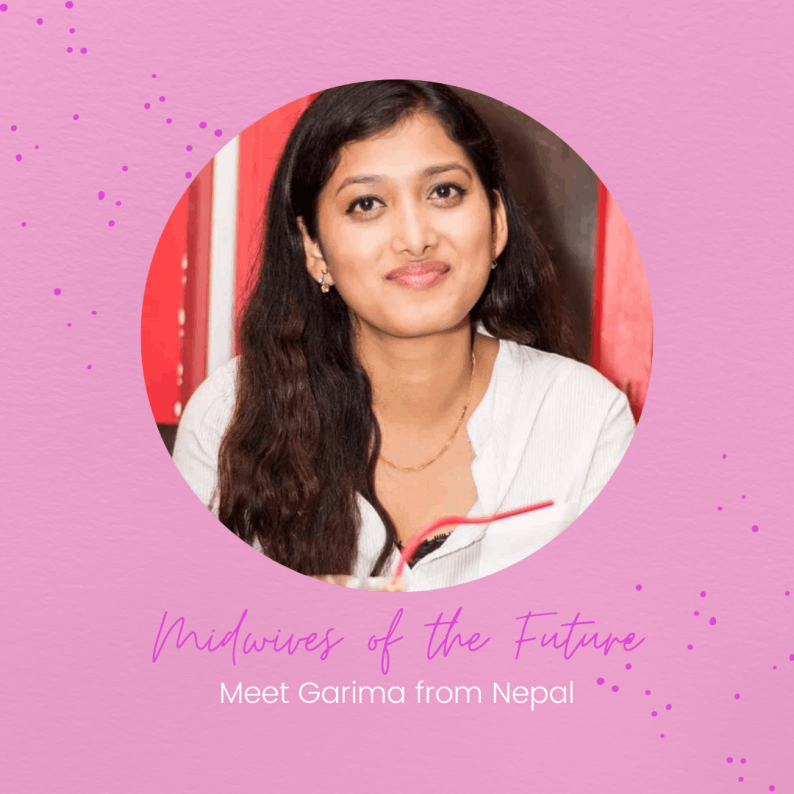GARIMA NEPALI
25 years | Kathmandu, Nepal
I was working as a nurse-midwife at the primary health care level in Jhapa, a rural Eastern part of Nepal for three years. The facilities in this area are very minimally equipped. Women are very vulnerable and need to travel for more than 2-3 hours to get access to a health facility. Health outcomes of women in rural areas are worse compared to those in urban areas and we encountered challenges to reach women for antenatal check-ups. Early marriage is a also big problem where I live and work.
________________________________________________________
"The youngest person I assisted to deliver was only 15 years old."
As a government employee working in the peripheral area I received a two months training focusing on delivery. The youngest person I assisted to deliver was only 15 years old. This is when I realized childbirth does not start with labor 12 hours before birth, but it is a whole cycle: women need to get prepared for birth long before, during, and after delivery. We need to provide the best skills and I realized to do so I need more than a two months long training.
In 2017 I decided to enter the midwifery BA program in Kathmandu. We are 14 students in my class. Theoretical teaching in the classroom is combined with practical sessions in the skills lab using Mama Natalie and other mannequins. I am in my third year and was supposed to graduate this year - but because of Corona I am at home since January. We had only a few online classes, but four out of 14 students did not have any internet – so we are really behind with our studies.
At my University we had a midwifery teacher from the UK named Margaret Walsh. In contrast to the other lecturers, who are nurse-midwives - she was the only midwife. She was someone we all looked up to. She taught us to apply all steps to support women: to inform them about their rights, accept a woman’s boundaries, that we need to bond with her, connect with her and share her pain.
Since being a midwifery student, I reflected very much on my previous practice: At the time I started to work as a nurse I was only 19 years old and there was a lot of pressure on me. At the primary healthcare level, you are totally alone and there is no one to help you, no one to look up to. I did a lot of deliveries but at the time my focus was on the outcome only: I had to make sure that the baby was delivered without complications! But since studying midwifery I realized we need women-centred care. Birth is a totally physiological process and the woman’s rights need to be preserved, we need to ensure respect and dignity.
As a midwife you have not only the responsibility for the childbirth but also neonatal health, routine check-ups, pre-conceptional counselling, and postnatal care up to 21 days after the delivery. Where I live and work, women do not know what their reproductive rights are - even if she is being treated bad she won’t know! As a midwife I can now also advocate for her rights, support her and teach her so that she can inform others that one needs to be treated with respect.
The midwifery program in Nepal exists for four years and so far, we have only nine registered midwives in the whole country but only few are working clinically. The midwifery program was established to reduce maternal mortality and morbidity but until now there are no established staff roles for midwives, no placements and no work plan. There is also no career path as we do not have further midwifery education. “We are kind of in a dilemma as the government of Nepal is not doing anything and due to COVID-19 we cannot advocate for our programs and needs.” It is somehow a sad situation: to know that maternal mortality is high, there are midwives, but we do not have any future it seems.
I will go back to my previous job working in the Eastern and rural part of Nepal at the primary care level. I understand the grassroots level and I think this is where I can make a difference. I dream to work independently as a midwife and to establish a real midwifery-led setting. “… during my [previous] education I did not have any kind of role model, …or someone to look up to… [I did not know] …how a midwife should work, how a midwife can help, how a midwife can be more beneficial and how she can be a role model. I want to work in that kind of way so that future midwives have someone to look up to and they [realize] this is how midwives should work, this is a way how midwives help a woman during her delivery process, during her childbirth, during her antenatal to the postnatal period. And this is how a woman is respected…”
So far, we have only seen a midwife-led unit in a video during our studies. Seeing such a positive environment was beautiful. I want to create something like this – where midwives can upgrade their skills and where women can feel safer and more relaxed.
For now, I want to work in the rural areas for some years and gain more experience. But afterwards I want to gain further midwifery education and become an educator and teach midwives of the future.
Interview by Leah F. Bohle, 26 November 2020
Photo by Garima Nepali
